Samsung Galaxy S10 Plus review: the very definition of feature-packed
The Galaxy S10 Plus is the most powerful, most expensive Samsung smartphone ever launched... but is it worth it?

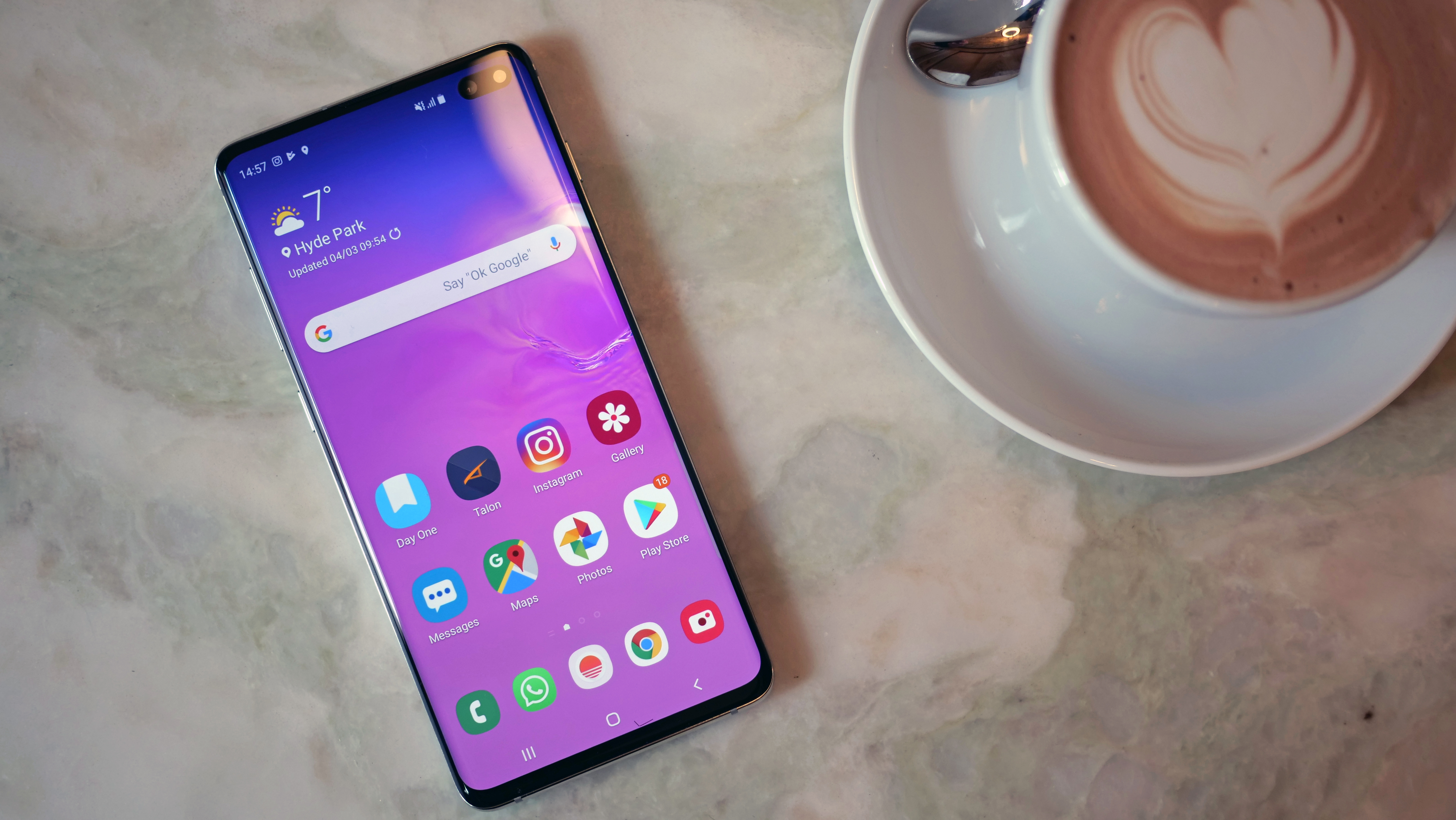
If you’re looking for the biggest, fastest, most feature-packed Galaxy smartphone available now, the Samsung Galaxy S10 Plus is it. At least, until the Galaxy S10 5G and Galaxy Fold launch. The Galaxy S10 Plus boasts the same stunning fit-and-finish we've come to expect from Samsung, but now sports a bigger display, bigger battery, more camera features, and faster internals. If you’re looking for the ultimate Samsung Galaxy S10, look no further. However, those who aren't already convinced by mammoth displays, likely won't find enough here to reconsider.
-
+
Phenomenal Build Quality
-
+
Expansive 6.4-Inch Quad HD+ AMOLED
-
+
Live Focus Images From Front-Facing Camera
-
+
Up To 1TB Of Built-In Storage
-
+
3.5mm Headphone Port
-
+
Water Resistant
-
-
Can Cost Up To £1,399
-
-
Infinity-O Display Is A Little Unsightly
Why you can trust T3

Samsung Galaxy Note 10 Key Specs

Dimensions: 157.6 x 74.1 x 7.8mm
Weight: 175 g
Screen: 6.4-inch AMOLED, 1440 x 3040 at 522 ppi
CPU: Qualcomm Snapdragon 855 / Exynos 9820
RAM: 8GB / 12GB
Storage: 128GB / 256GB / 1TB – up to 1TB via MicroSD card
Battery: 4,100mAh
Cameras: 12MP main + 12MP telephoto + 16MP ultra-wide / 10MP selfie
OS: OneUI / Android 9.0 Pie
If you're thinking if the Samsung Galaxy S10 Plus is worth buying over three years after it first launched then this review should help.
Multiple new Samsung Galaxy phones have now been launched after the S10 Plus but, despite this, its impressive key features, including a large 6.4-inch screen, still quite quick Snapdragon 855 processor and capable triple rear camera system, mean at its new low-low price in 2022 it is absolutely worth checking out.
Is the S21 Plus the best Android phone in the world? No, of course not, but it is a very capable handset that offers a lot of bang for, right now, not much buck.
Read T3's full Samsung Galaxy S10 Plus review now to find out what this handset offers.
- Samsung Galaxy S10 review
- Samsung Galaxy S10e review
- Samsung Galaxy Note 10 vs Samsung Galaxy S10 Plus

SAMSUNG S10 PLUS REVIEW: SCREEN AND HARDWARE
The Galaxy S10 Plus marks the tenth anniversary of the hugely-successful Galaxy S. Since the launch of the Galaxy S in June 2010, Samsung has moved from a 4-inch AMOLED display, plastic case, and 5MP rear camera to a 6.4-inch curved AMOLED with an embedded fingerprint scanner, glass and aluminium case, rear-mounted triple-camera and dual-selfie cameras.
Appropriately, the Galaxy S10 Plus feels like a culmination of everything Samsung has achieved over the last decade. Unlike the Samsung Galaxy Fold, which looks like the first, tentative step in the next decade of innovation, the Galaxy S10 Plus feels more predictable, but more refined.
If you’ve owned any Samsung flagship phone launched since the Galaxy S6 Edge in March 2015 then you’ll know what to expect with the Galaxy S10. The hardware feels incredibly well-built. The curvaceous front and back glass feels solid in the hand and while the aluminium band doesn’t have quite the same premium heft as the stainless steel on the similarly-priced iPhone XS, that’s a tiny nitpick in an otherwise outstanding piece of hardware. Although Google Pixel handsets price-match the Galaxy range, they can’t hold a candle to Samsung in terms of build quality.
Get all the latest news, reviews, deals and buying guides on gorgeous tech, home and active products from the T3 experts
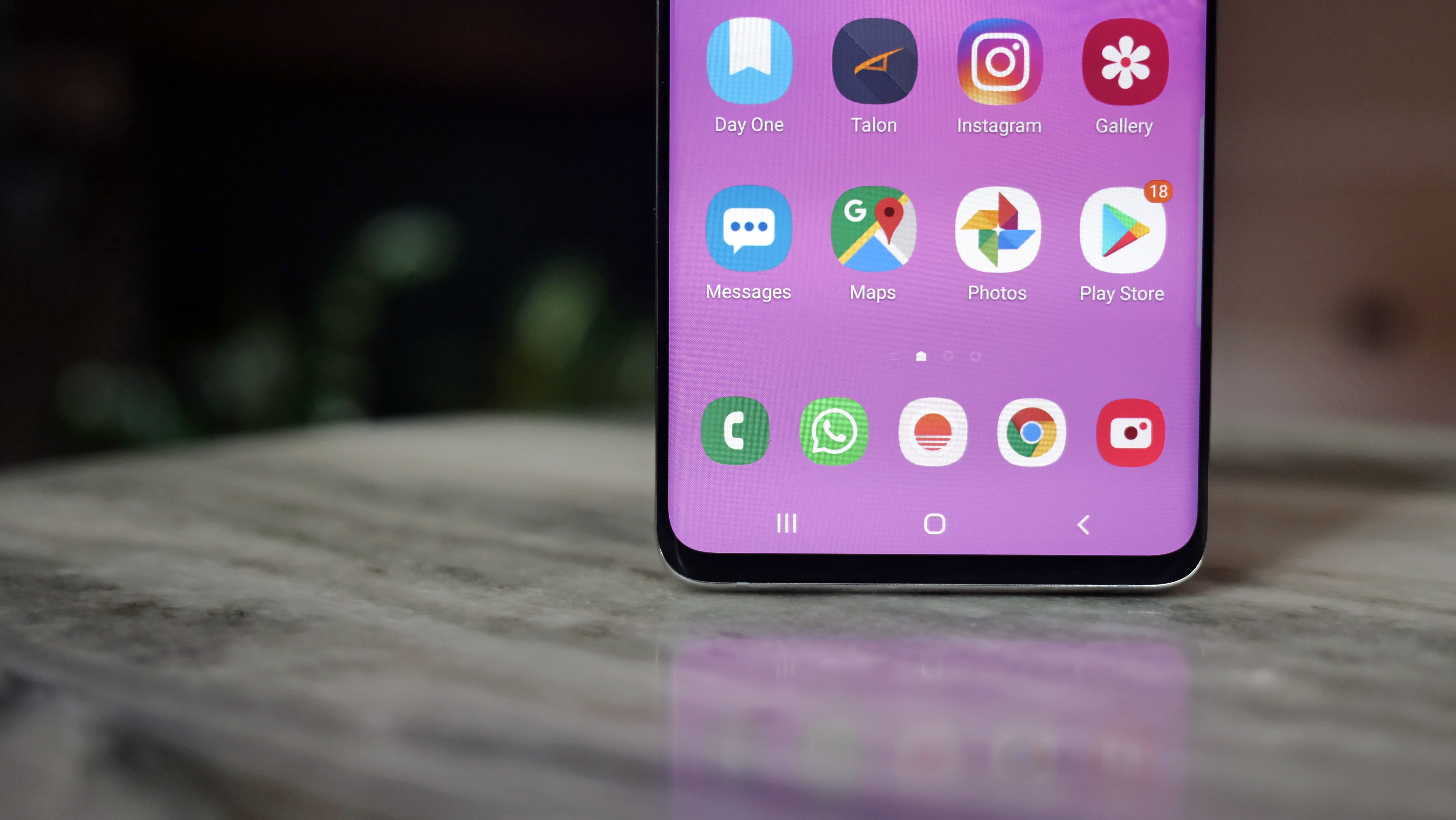
The first thing you notice about the Samsung Galaxy S10 Plus is the expansive 6.4-inch Quad HD+ AMOLED display. Although there is a small bezel around the display, it really feels like the screen fills every available corner of the handset.
The 6.4-inch panel isn’t too much of a step-up from the 6.2-inch screen on the Galaxy S9 Plus, but does mean the Galaxy S10 Plus matches the Note 9. Until now, Samsung has always used its Galaxy Note series to offer customers more screen real estate in the name of productivity, so the Galaxy S10 marks an intriguing shift for the South Korean company.
Size aside, the OLED panel on the Samsung Galaxy S10 Plus is absolutely stunning. It’s bright, with gorgeous colours and cavernous blacks. It’s a genuine joy to behold. It’s a delight to gorge on a boxset during your commute on that astonishing screen.
Samsung offers two settings for the display – Vivid and Natural. The latter is the default and is a little more subdued than some of the previous entries in the Galaxy S series. As the name suggests, setting the display to Vivid cranks up everything until the colours are zingy and oversaturated. It’s an acquired taste, and we’d firmly recommend turning it off.
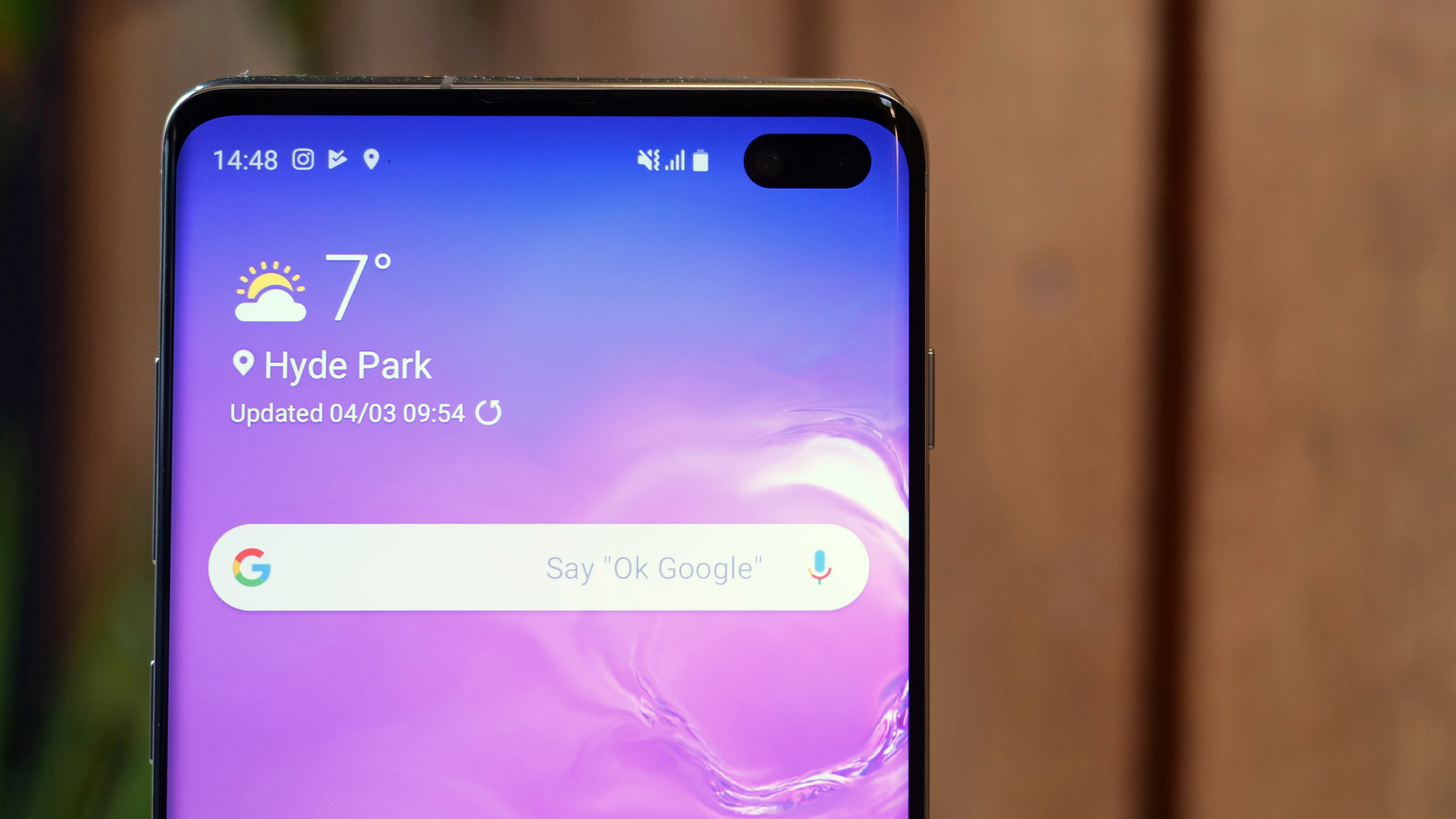
The Infinity-O keeps the Galaxy S10 feeling small, despite it's massive screen size, although the design does take some getting used to ...

... Samsung includes a option in the settings to disguise the cycloptic cut-out, but somehow that's just worse
Despite its pocket-stretching screen size, the Galaxy S10 Plus is physically smaller than its predecessor – 157.6mm vs 158.1mm, for all you stat-hounds. Clearly, you don't need to be a member of the Magic Circle to work out the secret behind this trick is Samsung’s all-new Infinity-O display, which rehouses the front-facing selfie camera – typically found in the bezel above the screen – into a small hole-punch in the top right-hand corner of the panel. The proximity and ambient light sensors are also embedded underneath the screen.
Although Samsung debuted the Infinity-O design with the mid-range Galaxy A8s, this is the first handset to use the design with a Quad HD+ AMOLED panel.
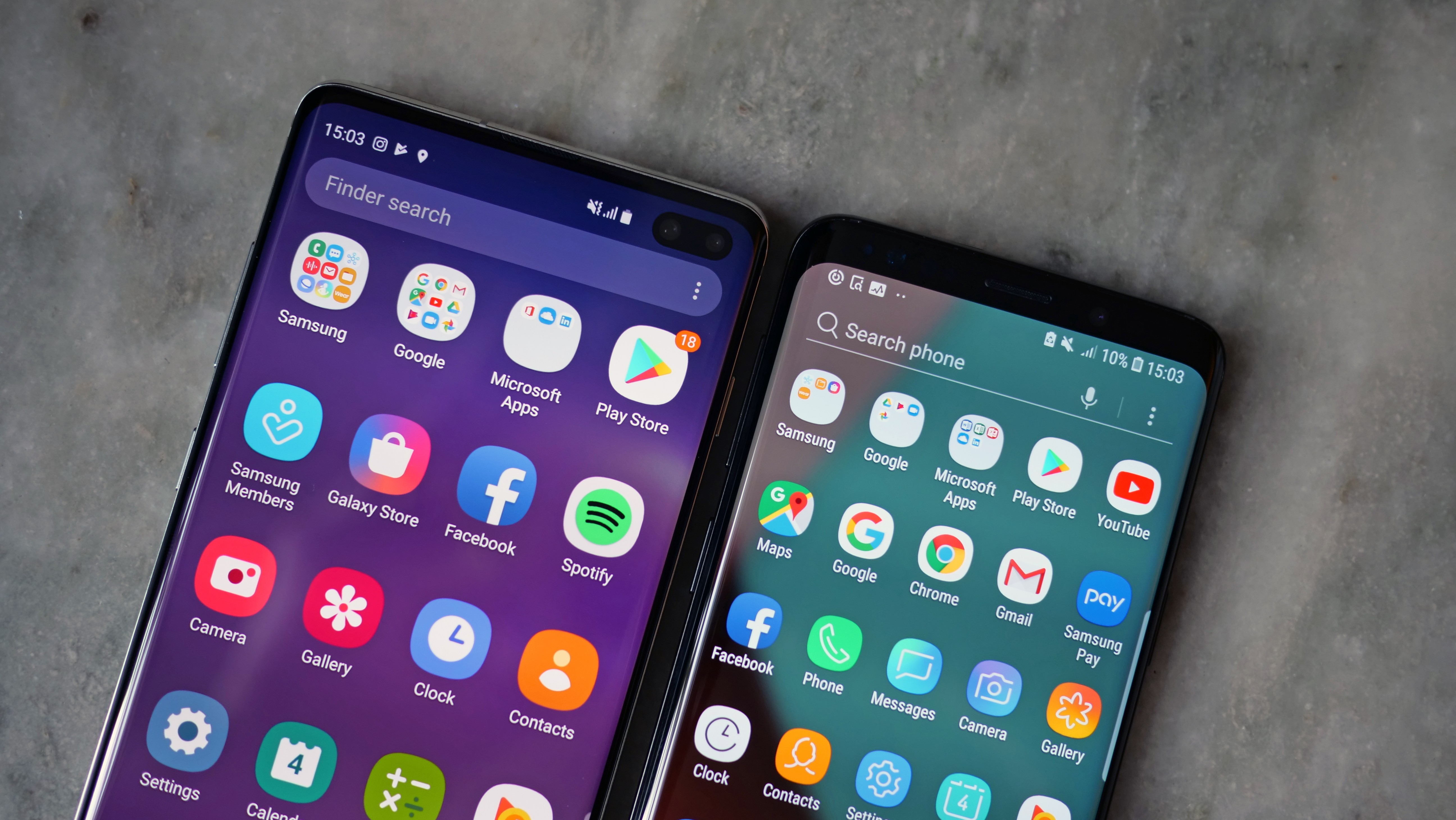
When placed side by side with the Galaxy S9, it's easy to see what a difference the new Infinity-O design makes
The new display design does an outstanding job of making a smartphone with a 6.4-inch screen feel manageable in the hand. The dual-curved edges mean the Galaxy S10 Plus isn’t as wide as rivals like the iPhone XS Max, so typing one-handed while juggling a takeaway coffee isn’t impossible, although it does take some practice. However, the Infinity-O isn’t the prettiest design and does take some getting used to. Samsung does a pretty good job of obscuring the hole-punch camera with some aggressive shading in the top right-hand corner of its preinstalled wallpapers.
However, when you’re presented with a bright white screen – like every time you launch the Messages app – the pill-shaped cut-out for the dual front-facing is a real cycloptic eyesore. It also means the battery life, WiFi, and 4G signal icons are shifted into an asymmetrical position close to the centre of the screen, which looks pretty awful.
Samsung has publicly mocked rival smartphone manufacturers for including a notched display in their smartphones to house the selfie camera, speaker and sensors in an all-screen design – we’d take the design of the Huawei Mate 20 Pro or OnePlus 6T any day over the off-centre lanyard cut-out sitting at the top of the otherwise gorgeous Samsung Galaxy S10 Plus.
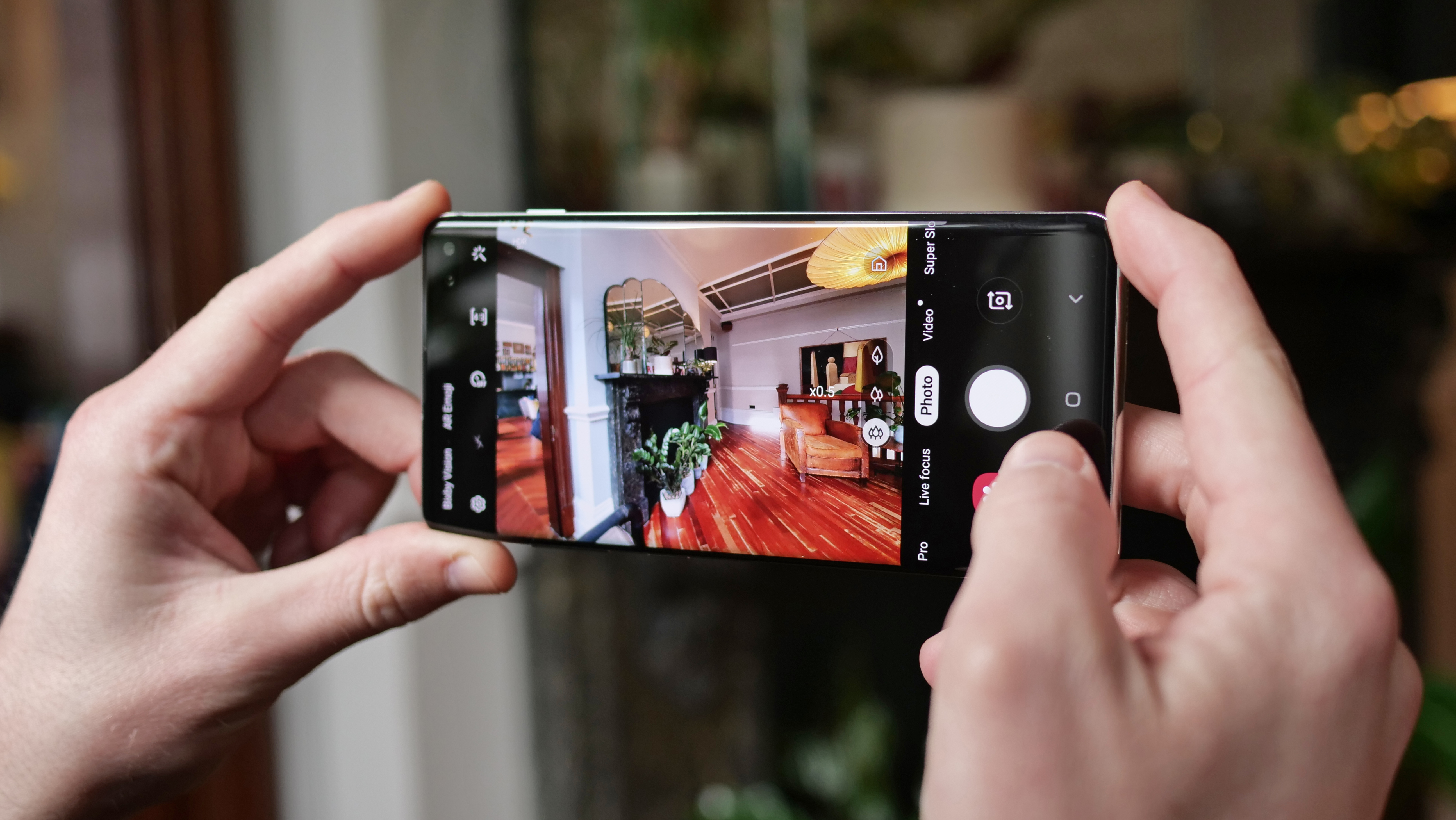
SAMSUNG GALAXY S10 PLUS REVIEW: CAMERA
What the dual selfie cameras on the new Samsung flagship lack in beauty, they more than make up for with functionality. The Galaxy S10 Plus, which is the only model in the S10 range with dual front-facing cameras, is the only device capable of shooting Live Focus selfies. These photographs add an adjustable, artificial bokeh-style blur to the background behind the subject.
While this is commonplace on almost all flagship smartphones, Samsung has added a number of extra effects to its Live Focus feature this year. “Colour Point” turns the background greyscale so that only the subject is left in colour, while “Zoom Bokeh” and “Spin Bokeh” make it look like you’re racing towards the camera or speeding around on a roundabout, respectively.
“Colour Point” is easily our favourite and produces some really nice shots – even with our admittedly clumsy selfie skills. “Zoom Bokeh” and “Spin Bokeh” could make for a fun Instagram post, but won’t be anything we’ll be going back to after an initial snap.

"Colour Point" uses the depth-map captured by the camera to highlight the subject of the image in colour, while blending bokeh-style blur and greyscale in the background
Samsung deserves some praise for trying something completely original and not blindly copying the Portrait Lighting feature introduced with the iPhone XS as so many Android manufacturers have done (here's looking at you OnePlus and Honor). The new Live Focus modes produce usable shots more reliably than Portrait Lighting, too.
And if wacky effects and bokeh aren’t your bag, you’ll be pleased to know the standard selfies on the Samsung Galaxy S10 Plus camera look great. While the photos aren’t quite as sharp and detail-packed as those shot on the rival Google Pixel 3, we don’t necessarily feel the need to see each individual hair and pore – so are perfectly happy with the results from the Galaxy S10 Plus.


Flip over the Galaxy S10 Plus and you’ll find the new triple-camera. This new rear-mounted system includes a 12MP wide-angle camera with Optical Image Stabilisation (OIS) and a variable aperture that can switch between f/1.5 and f/2.4. It’s the same system introduced with the Galaxy S9 and Galaxy S9 Plus last year and still works just as well. Although the variable aperture on the S10 Plus doesn’t work quite as well as the latest software solutions, like Night Sight on the Google Pixel 3 which picks out details and colours barely visible with the human eye in darkness.
Alongside the main camera, you’ll find a 16MP f/2.2 ultra-wide sensor and a 12MP telephoto lens with f/2.4. Using the new triple-camera, Samsung has enabled 0.5x wide-angle shots, the same as those seen on the Huawei Mate 20 Pro, as well as 2x optical zoom. Both new modes are a cinch to access thanks to a small pop-up that appears in the default camera mode (tap the icon of the forest to zoom out, and the icon of the leaf to zoom-in). While Samsung once had an – admittedly, well-earned – reputation for saddling its smartphones with gimmicky features that you'd never use after the demo on the shop floor, but these new additions are genuinely useful.

Shooting a high-rise with the wide-angle camera on the Galaxy S10 Plus is a pretty standard affair ...

... but flip over to the ultra-wide angle camera and you get something genuinely special
In particular the ultra-wide can produce some really striking photos. The 0.5x zoom is also incredibly useful when trying to take photographs of skyscrapers and architecture that would normally require you to retreat to the other side of the road to fit into the viewfinder. The 2x optical zoom is likely to be popular with those who take photos at concerts and want to give the impression they were in the front row, whilst simultaneously avoiding the squeeze.
However, with Huawei pushing the boundaries with the 3x optical zoom on its P20 Pro and Oppo revealing early prototypes of smartphones with 10x optical zoom … it’s starting to feel a little outdated.
Those who are worried that Samsung has neglected to add any superfluous features into the Galaxy S10 Plus – don’t panic! The all-new Shot Suggestions feature is a gimmicky new addition that uses AI to suggest the best composition for whatever you’re lining up in the viewfinder. Samsung adds a spirit-level line that cuts across the entire screen, which is pretty useful, but there’s also a dot that Samsung believes should be in the centre of the shot. Samsung says it has analysed 100 million high-quality photos to create the rules used by Shot Suggestions, but it seemed to basically boil down to the simple rule-of-thirds and always wanting Wes Anderson-esque straight angles everywhere. Thankfully, it’s not switched on by default.
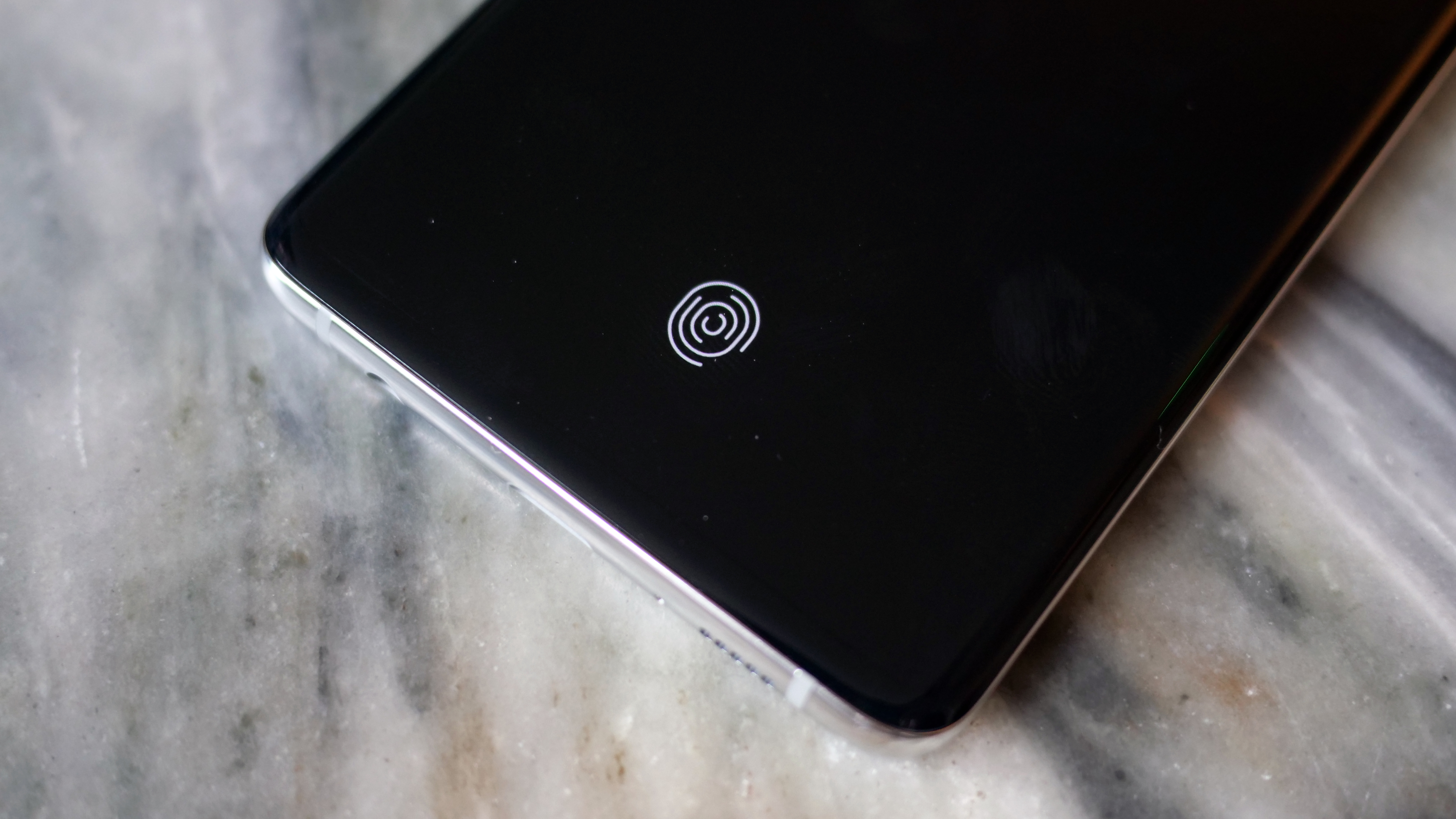
SAMSUNG GALAXY S10 PLUS REVIEW: ULTRASONIC FINGERPRINT SCANNER
With the Galaxy S10 Plus, Samsung has finally ditched the rear-mounted fingerprint scanner, which will be music to the ears of anyone still using the Galaxy S8 Plus and its teeth-grindingly finicky sensor placed beside the camera lens. Instead, the biometric sensor is now found underneath the AMOLED display. We have always preferred front-facing fingerprint scanners – not least because it means you can unlock the phone and authenticate secure apps when the handset is resting on your desk or charging without having to pick it up.
Unlike the Huawei Mate 20 Pro and OnePlus 6T, which use an optical in-display fingerprint scanner, Samsung has opted for an ultrasonic sensor – the first to do in a smartphone. The Seoul-based company claims its ultrasonic scanner is more reliable than rival solutions since it uses soundwaves instead of light, which means it can continue to work in tough weather conditions, including heavy rain. Samsung says it’s more secure than optical scanners since it’s capable of recording every single ridge on your fingertip.
While we can’t vouch for exactly how many of the ridges in our fingerprint the ultrasonic scanner managed to record, Samsung’s claims about the ultrasonic sensor working in a downfall is absolutely not hyperbole. Unlike previous Galaxy S handsets, the fingerprint scanner on the Galaxy S10 doesn’t even break a sweat when the glass is wet, meaning you’ll be able to unlock the handset when you’re in the middle of the washing-up, working out in the gym, or clammy handed walking to a job interview without issue.

If you're paying attention, it can be easy to miss the exact spot on the screen – much easier than traditional physical sensors
That’s not to say the ultrasonic scanner is infallible though. Samsung highlights the area of the screen above the sensor with a fingerprint icon. However, you have to be fairly precise with the placement of your digit.
Absent-mindedly pulling out the phone and trying to unlock it while navigating pavements bustling with weekend shoppers lead to the phone telling us to “cover the entire fingerprint sensor” a fair few times.
Overall, we’ve been impressed with the new ultrasonic and prefer it to the small physical sensors nestled next to the cameras on the last two generations of Galaxy S smartphones.

SAMSUNG GALAXY S10 PLUS REVIEW: SOFTWARE, BATTERY, AND OTHER FEATURES
The Galaxy S10 Plus runs the phenomenal, Samsung-designed One UI mobile operating system, which is based on Android 9.0 Pie. In the past, the words “phenomenal” and “Samsung-designed mobile operating system” would never have been found in the same sentence – but the South Korean company has really pulled it out of the bag with its latest reimagining of Android.
The new mobile software acknowledges that while we all want massive screens on our smartphones, massive smartphones are annoying to use, especially one-handed while walking or squished into the carriage of a train a morning commute. To solve the headache of using an expansive 6.4-inch display, One UI shifts all the elements of the user interface that you’ll actually need to tap into the lower-third of the touchscreen where they are within easy reach.
It’s a bit like the Reachability feature that Apple introduced a few years back, which temporarily drops the entire screen into the lower-half of the display, but applied across an entire user interface. Even swiping on the notification shade drops the quick action toggles far enough down the display that you won’t need to perform thumb-gymnastics to hit the right icon.
Samsung fills the top of the display with comically-large menu titles. When you first pick up the Galaxy S10 Plus, it looks very odd. But as soon as you start using the 6.4-inch smartphone, it all makes sense. For those accustomed to the TouchWiz operating system that powered older Galaxy S handsets, One UI is going to take some serious getting used to. But it’s worth it.

One UI has some seriously big titles at the top of the screen, but it keeps everything reachable ... or just about
Not everything about One UI is perfect. Some of the default Samsung application icons are a little gaudy, and there are still some duplicates between Samsung and Google apps – why do I need two stores and two calendars? There’s also a question mark over whether Samsung will keep One UI updated as quickly as rivals like Motorola and OnePlus, which just about keep pace with Google and its Pixel-branded smartphone when it comes to Android OS updates and security patches. Until now, Samsung has always dragged its feet, but fingers crossed that changes with its new-look software.
Fuelling the Samsung Galaxy S10 Plus is a 4,100mAh battery cell. For comparison, that’s bigger than the battery in the Galaxy Note 9, despite its larger footprint. In our time with the Galaxy S10 Plus that mammoth battery was more than enough to keep the device powering through a full-day of heavy usage. With some restraint, it’s easy to eke out a day and a half between charges.
That extra battery comes in handy thanks to a new feature called Wireless PowerShare that allows owners to top-up any device capable of wireless charging using the Samsung Galaxy S10 Plus. The new feature is enabled in the settings, then you simply flip over the phone and place any Qi-compatible gadget on the case to start charging. If that sounds at all familiar, it’s probably because Huawei first introduced this feature with the Mate 20 Pro last year. Wireless PowerShare on the Galaxy S10 Plus is a little finicky to find the exact spot on the uniform glass case to activate the charge, but after a few tries we got pretty good at locating it.
Granted, Wireless PowerShare is not going to be the feature that pushes you to upgrade from an older Galaxy S model, but it’s a handy addition and means you can help-out a friend in need who has forgotten to pack an external battery pack and USB charging cable on a night-out. It also works phenomenally well with the Galaxy Buds – the new AirPod rivalling Gear IconX successors announced alongside the S10. You can place these on the back of the Galaxy S10 Plus while it’s on charge to refuel both gadgets with a single USB-C cable – useful it you want to travel light.
Contrary to the rumours in the months ahead of the launch of the Galaxy S10 Plus, the 3.5mm headphone port remains intact so there’s no need to throw-out your wired cans or cough-up for a 3.5mm-to-USB-C dongle. Like its predecessor, the Galaxy S10 Plus is rated IP68 for water and dust resistance, which means it’ll withstand a swim in 1.5metres of water for half an hour.

SAMSUNG GALAXY S10 PLUS REVIEW: VERDICT
If you’re looking for the biggest, fastest, feature-packed Samsung Galaxy smartphone available right now, this is it. At least, until the Galaxy S10 5G and Galaxy Fold launch in a few months.
The Galaxy S10 Plus boasts the same premium build quality and stunning fit-and-finish we've come to expect from Samsung, but now sports a bigger display, bigger battery and faster internals. There’s also new camera features you won’t find on anywhere else in the Galaxy S10 range and while some are undeniably gimmicky, others are decidedly not.
If you’re looking for the ultimate Samsung Galaxy S10, look no further. But if you’ve never been a fan of mammoth smartphone displays, the new Infinity-O display and new One UI software tweak probably aren’t enough to convince you to reconsider.
• Samsung Galaxy S10 Plus launched worldwide March 8, 2019. Prices start from £899. Galaxy S10 Plus ships in Prism White, Prism Black, Prism Green, Prism Blue, Ceramic White, and Ceramic Black
- Best Samsung Galaxy S10 Plus deals available right now
- Samsung Galaxy Buds review
Samsung Galaxy S10 Plus: News, Updates
Since we published our Galaxy S10 Plus review, some new details about the Samsung handset have emerged. We'll keep you posted about all of the latest updates here, in case they change how you feel about the handset...
27 March 2019: First up, Samsung has confirmed that Galaxy S10 owners who don't specifically tick the option to enrol their device in the company's Samsung Premium Care scheme when they check-out online cannot sign-up after the fact.
This baffling quirk also occurred in the months following the launch of the Galaxy S9 and Galaxy S9 Plus last year, with those who hadn't immediately opted-in during the check-out process left unable to register until September. Fingers crossed Samsung doesn't leave it quite that long this time around. For those who don't know, Samsung Premium Care is an upgraded warranty scheme that provides accidental damage protection for your Galaxy flagship, similar to AppleCare+.
In the meantime, we'd recommend getting a case. Or being very careful when using your Galaxy S10 Plus as repairs for this all-glass flagship can be mightily expensive.
1 April 2019: Samsung's second over-the-air software update for the Galaxy S10 phones – the March 2019 update – brought with it improvements to Wireless PowerShare and camera stability. As a result of the update, The heart rate sensor on the rear of the Galaxy S10 Plus (and the Galaxy S10) will light up to indicate that Wireless PowerShare is being used.
According to SamMobile, when you enable Wireless PowerShare, you’ll see a blinking blue light which turns red when you you place another device against the phone and wireless charging begins. When the device you’re charging reaches full charge,the light will go dark. If you want to install the update manually rather than wait for it to arrive, go to 'Settings', 'Software update' and tap 'Download updates manually'.
3 April 2019: Google Duplex is now rolling out to Samsung Galaxy S10 Plus users in the US. Previously only available on the Pixel 3, and even then only in four cities, Google has said that Duplex will become available in 47 states and on other Android and iOS devices, and XDA Developers has confirmed that it is now rolling out to the Samsung Galaxy S10 Plus.
Google Duplex is the slightly creepy service Google showed off at its Google IO developer conference in May 2018. Part of Google Assistant, Duplex can call restaurants, hairdressers and other businesses to make appointments on your behalf so you don't actually have to speak to a human until you arrive for your appointment.
23 April 2019: The latest Galaxy S10 Plus update improves Wi-Fi stability. According to Tizen Help a 205.18MB update with the firmware version of G975FXXU1ASD5 / G975FOXM1ASD4 / G975FXXU1ASD4 is now rolling out. As well as improving Wi-Fi stability, the software patch also brings a dedicated night mode option to the camera app so users can launch the mode manually whereas previously it would only launch automatically in low light situations. The update should arrive automatically as it rolls out, but it can also be found in Settings > Software update.
29 April 2019: The April Samsung Galaxy S10 Plus update may have also improved the S10 Plus' battery life. The improvement was noticed by a writer at Sammobile, who says his S10 Plus has gained about an extra hour of time between charges. Although the writer hasn't been able to pinpoint the reason for this improvement he notes that "I’m pretty sure it’s not a coincidence that my S10+ is lasting longer after the most recent software update".
17 May 2019: Samsung has launched a Samsung Galaxy S10+ Olympic Game Edition to commemorate the 2020 Summer Olympics which take place in Tokyo. The handset features a Tokyo 2020 logo on the back, while a similar design appears on an Olympic Game Edition pair of Galaxy Buds, which come with the phone. This special edition S10+ ican be ordered in Japan now from Docomo for $1,000. According to GSMArena there are only 10,000 units of this special edition handset being produced and it’s not clear if this model will be available outside of Japan.
17 May 2019: It seems that while Galaxy phones outside of the US have received the night mode update, it has not yet made it to US carrier-locked handsets. Sammobile notes that Sprint is the first to release the May patch which features a security update and dozens of bugs fixes but not the night mode at this time. Sammobile says that with this monthly patch cycle complete it could be another month before night mode makes it to US Galaxy handsets.
21 May 2019: Samsung is readying a new 'Cardinal Red' version of the Samsung Galaxy S10 Plus, according to The Verge. It's not known when the new colour will go on sale or in which countries. If accurate, this would bring the number of available S10 colours up to 10. Apparently the new colour is also coming to the Samsung Galaxy S10, while it's not known if it will make it to the budget Samsung Galaxy S10e.
14 August 2019: Samsung is back on track with its pledge to roll-out software updates faster to its new One UI-touting handsets. The entire Galaxy S10 line-up has been updated across a number of European markets with the latest security patches today. The Seoul-based company pushed-out its July update much slower than average, despite the update not including any new features or design tweaks.

As a former Staff Writer for T3, Aaron writes about almost anything shiny and techie. When he’s not barking orders at Alexa-powered microwaves or gawping at 5G speed tests, Aaron covers everything from smartphones, tablets and laptops, to speakers, TVs and smart home gadgets. Prior to joining T3, Aaron worked at the Daily Express and and MailOnline.